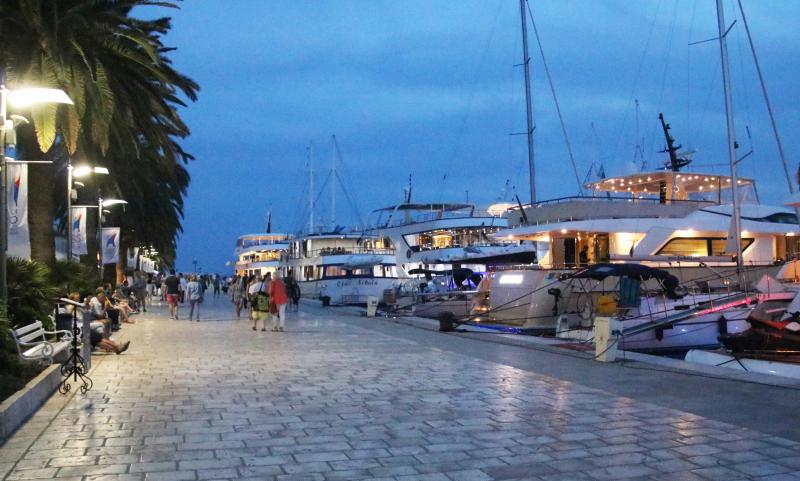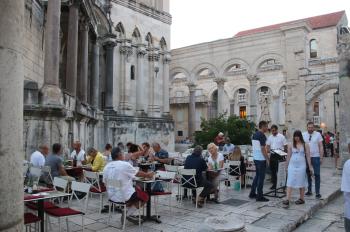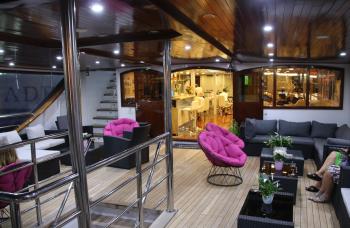Spending a week cruising the Dalmatian Coast
This article appears on page 20 of the July 2019 issue.
Last month, I recounted the 9-day trip my wife, Betty, and I took to Slovenia and Croatia. This month, I’ll concentrate on the 7-day trip down and up the Dalmatian Coast, from Split to Dubrovnik and back to Split, that we took immediately after.
When our excellent trip to Slovenia came to an end, our guide, Sanjin, dropped us off in Split. It was there that we boarded a fairly small (by cruise-ship standards), 32-passenger boat for a trip booked with Adventure Life (Missoula, MT; 800/344-6118, adventure-life.com), a company we have traveled with before and liked. We paid $3,180 for two.
The boat, the Kapetan Bota, was captained by its owner, and some of his four daughters worked on board. There were a couple of deckhands who seemed to race around and do a lot of things, but, mostly, they were just nice to us, as was the whole crew.
The harbors of the islands we visited generally had four to eight similar boats anchored in each. In the larger harbors, giant cruise ships docked and their passengers immediately filled up all the little alleys, coffee shops and sidewalk restaurants, of which there were many. At about 6 p.m., the crowds would disappear back into their ships, and the towns seemed to breathe and slow down.
This was the first time Betty and I had traveled on a family-run ship of this size (it was 125 feet long), and we would do it again in a heartbeat. Having the owners on the boat ensured that everything was done well. The cabins and common areas were clean, the paint was fresh, and the service was excellent.
The small number of people on board meant that we interfaced with everybody in one way or another.
Starting in Split
Croatia is a place that has changed hands over and over throughout history. It is a place where different ethnic groups have vied for dominance and different religious groups have fought for control.
On the good side, every invasion and/or migration has left its mark on the cities and towns through its architecture and the attitude of the people themselves. This gave us a unique setting in which to spend seven relaxing days while getting a feel for what a medieval town might have looked like.
Split, where we started, was like any big town that draws visitors to its sites. It is where Diocletian built his palace, much of which still stands, now taken over by the residents of the city. It still has its very narrow, winding streets paved in cobblestones, with stone buttresses every now and then to keep the buildings from collapsing in on one another.
Diocletian’s Palace covers several city blocks, and it is still a functioning center. The stones Diocletian put down for his streets and buildings are still there. The 300 or so people who live within the palace walls live in the same stone structures Diocletian’s entourage lived in. You can imagine the transformation of a living city from AD 305 to now — 1,700 years, and very little, really, has changed except the people.
Thinking of all the things that had changed, were discovered, were invented and were destroyed or lost during those 1,700 years while sitting in that very place was significant.
Split is picturesque and, when the big tour boats leave, very nice to walk through, with an endless variety of shops, restaurants and ice cream vendors. Right along the waterfront, there was the usual line of curio shops and more ATMs than I had ever seen in my life. They were everywhere! (Croatia uses the kuna and will not accept any other currency, which might explain the ATMs.)
It was neither a cheap nor expensive place to visit. I never felt we paid too much, and I never thought we were getting a really good deal. It all seemed fair to me.
A good meal cost about $30 for the two of us, but if we wanted fresh fish, the sky was the limit. We had it one night, just as the restaurant was closing; I am sure they had fresh fish that they could not keep overnight and so we got two for the price of one. It was well worth it!
A typical day
Betty and I boarded the Kapetan Bota around noon, left our bags on board and went back into town. We slept that night, as every night, on the boat but generally had the afternoons to roam around the towns we stopped in.
In general, each day went like this:
• Breakfast (a buffet), starting at 7:00
• Free time to watch the coast go by until around 11
• An hour to swim (the water was cool to enter but felt good after a few minutes)
• Lunch, served at 12:30 by one of the captain’s daughters
• Tying up at the day’s city dock around 1 or 2 and taking an included tour of the most important sights in the city (generally a castle or fort only a few blocks away)
• Back in bed when we chose after an evening in town
The Croatian towns were very pretty. They are small; there are only four million people in the whole country. The towns reminded us very much of the hilltop towns in Tuscany, with stone buildings, narrow, winding streets and red-tile roofs.
All in all, we had a relaxing visit. The tours of the important sights were not too long, the distances walked were not too long, the hills were not too steep, and there was plenty of time to sit at a table and simply watch the people go by. And, the beer was good!
We liked the white wine very much, but, in my opinion, they have not mastered the red just yet. The Slovenians, on the other hand, have wine-making down to an art, both red and white.
From what I could tell, Croatia is just being discovered (for lack of a better word) by travelers. As a result, the streets are not full of people, the shop owners are eager to talk to you (English is used everywhere), and everybody is friendly.
We did not see a single large hotel in any of the towns we visited, and I hope it stays that way, but that will make it harder to stay in town as tourism increases (currently rising about 15%-20% a year). In other words, go now!
Our time on the boat was good. There was not too much and not too little. The interaction with the other passengers was nice, and we made some new friends along the way.
Coffee to go is not something you will find in Croatia. Coffee, the town, your friends, the warm air are all to be savored, and that takes time.
Exceeding our expectations
Croatia was not high on our list of places to go, and our preconceived idea of Croatia did not beckon us there. I am still surprised at how wrong we got it. Croatia is nothing like I had expected.
I was surprised at how modern the towns were and how their stewards had managed to attain that modernity without changing the ancient nature of the towns. They seem to have accepted the best of the modern world and kept the best of the old at the same time.
Our trip was just along the coastal area of Croatia, and it was beautiful. As our trip progressed, the towns seemed to run together, and it was hard to remember which was which. That said, I enjoyed every town, every street and every shop.
I slept soundly each night, not with the sense of relief that comes at the end a busy travel day but relaxed, thinking about all the history that had transpired on the very stones I had walked on.
Would I go back? Probably not. Would I recommend going if you have not gone? Absolutely!
You will fondly remember your trip to Croatia and its people and places, and maybe you will forget some of the world’s problems, at least for a little while.



